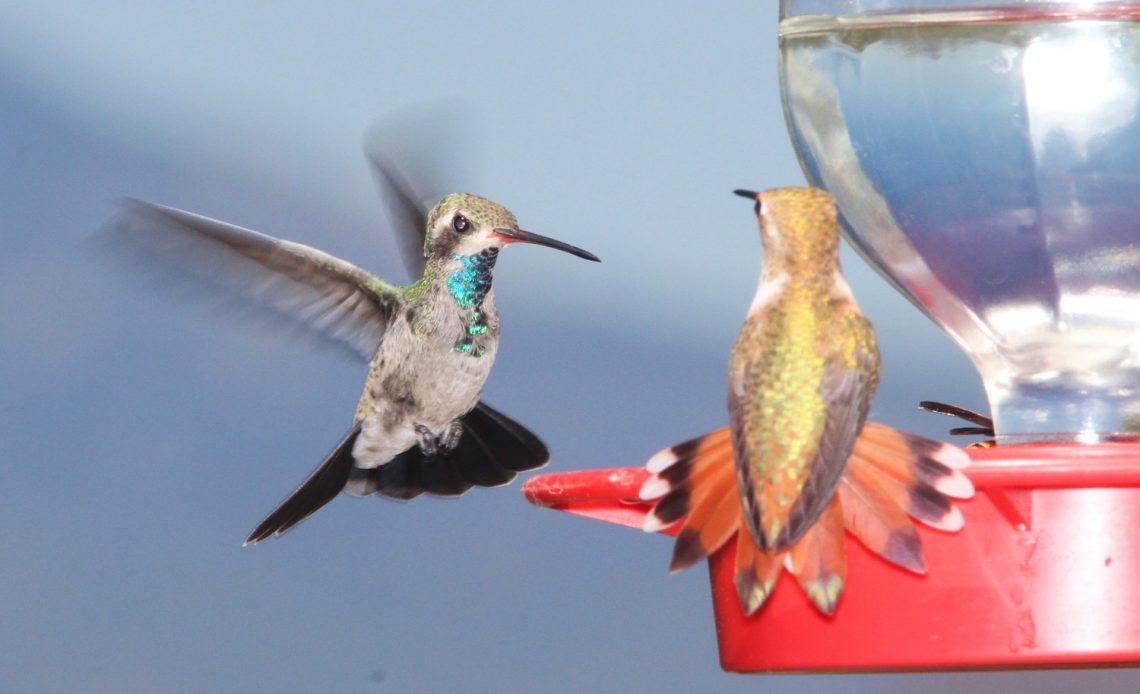

We’re here to help! Wild Yards is a completely free website that is 100% dedicated to helping you create a wildlife-friendly, sustainable yard. Read more
WildYards is reader-supported. When you buy a product through a link on our site, we may earn a comission. Every product is independently selected by our (obsessive) editors and our reviews are unbiased and objective. Read more about our mission or our privacy policy.
One of our favorite ways to unwind after a long day is by watching the hummingbirds darting around our feeders. These tiny birds are skilled fliers, and fascinating to watch. They can put on quite an air show! Hummingbirds can pull off some impressive moves, but some of their performances are downright confusing. If you’ve ever watched the hummingbirds visiting your feeders, you may be wondering, why do hummingbirds fly back and forth?
Hummingbirds often dart from one place to another, doggedly protecting their food sources and guarding their territories. But if you see a hummingbird flying back and forth rapidly, it’s likely a male engaging in mating behavior.
Why do hummingbirds fly back and forth all over your backyard?
Hummingbirds are super fast fliers. Sometimes, the reason you see them flying back and forth is simply because they’re trying to get from point A to point B, and then back to point A again.
But if you’re wondering why they’re flying back and forth so often there are actually a few reasons why they might be doing so.
Here are the 8 main reasons why hummingbirds will fly back and forth all over your backyard.
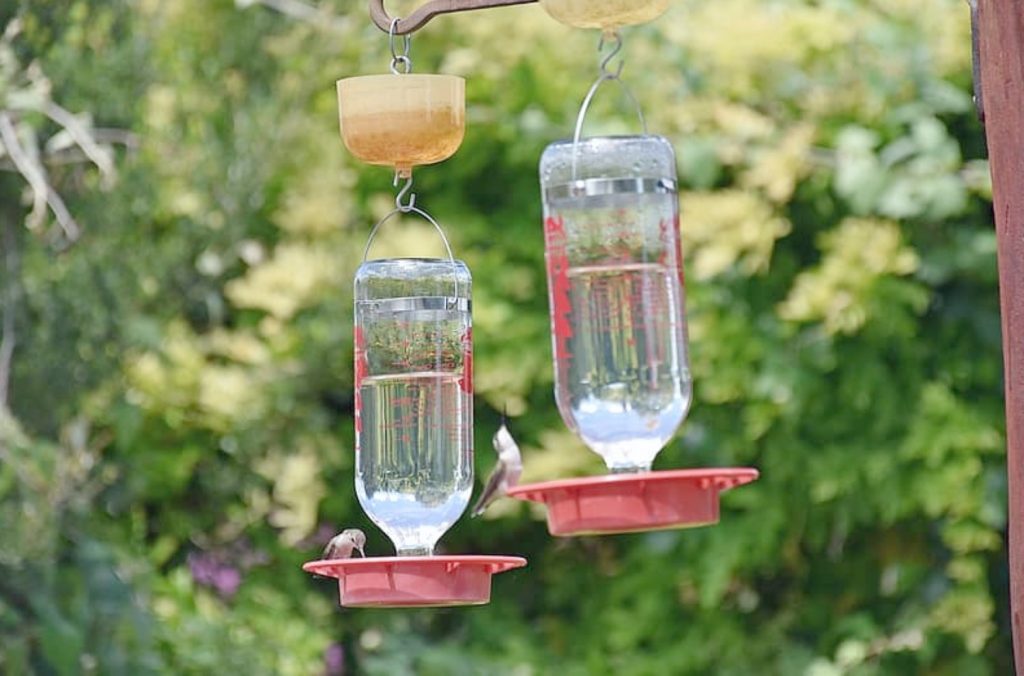
They’re performing courtship displays
During the courtship process, male and female hummingbirds will often engage in synchronized courtship displays. They’re quite the sight if you’re lucky enough to see them!
The pair of hummingbirds will fly together in close proximity, sometimes flying back and forth, other times flying up and down.
This courtship display usually happens shortly before mating, which is a separate process marked by its own unique “dance”.
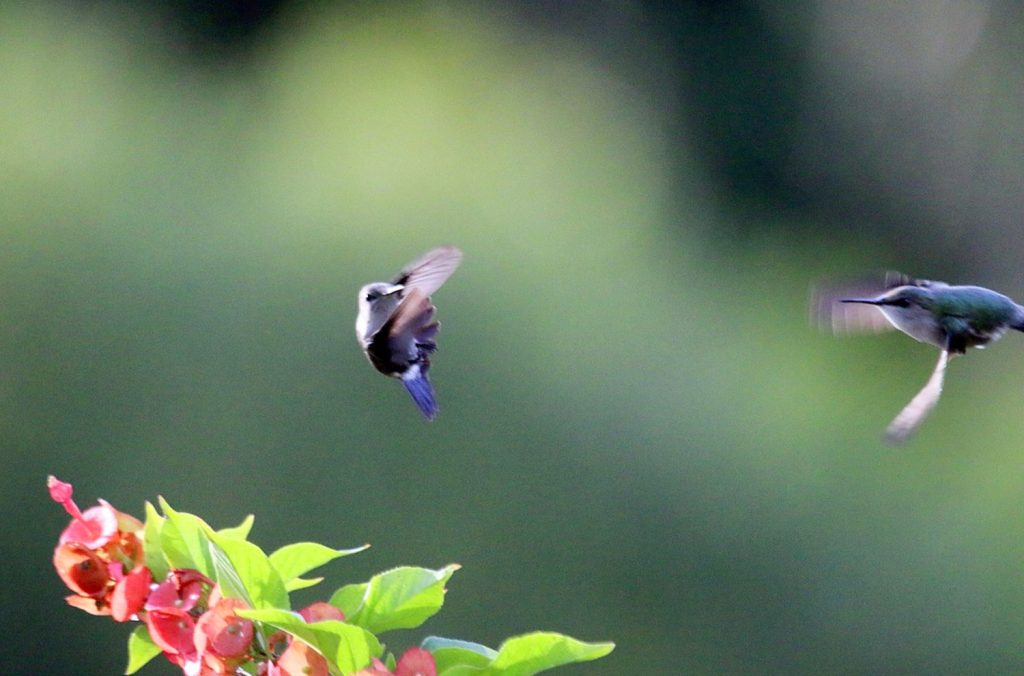
They’re engaging in mating behavior
More times than not, if you see a hummingbird flying back and forth rapidly, it’s a male engaging in a mating ritual.
Male hummingbirds will spread their tail feathers and lengthen their wings, displaying themselves in front of a perched female.
The male expertly swoops back and forth in front of the female, in the hopes of winning her affection. In rare instances, even female hummingbirds will engage in this behavior.
If you spot a hummingbird rapidly flying back and forth in front of another hummingbird, keep an eye on what they do next. Often, this mating behavior is accompanied by an impressive nosedive!
In order to attract a female, male hummingbirds will swoop up and down in front of them. The male will launch himself into the air at a height of 60 feet, then plunge straight to the ground in front of the female.
At the last second before hitting the ground, the hummingbird will make a U-turn, and fly back up again. The male hummingbird will repeat this impressive maneuver 3 to 4 times to win over a new mate.
Hummingbirds are lightning fast, so it can be difficult to catch either of these displays, but, if you listen carefully, you’ll hear the male making squeaking, clicking, and popping noises as he’s performing these moves.
If the female accepts the male hummingbird’s advances, she will let out high-pitched chirps, drop her wings, and assume the mating position.
After mating, male hummingbirds seek out new mates and protect the territory from other males as the female begins nesting.
They’re searching for nesting sites
Hummingbirds will fly all over to explore their territories. They look for places to hide from predators and places to sleep. They also search for good nesting spots.
Hummingbirds like to choose sheltered, out-of-the-way places for their nests, where they won’t be found easily. They may build their nests in shrubs with dense foliage, or in the small nooks and crannies of a tree.
Hummingbirds build their nests out of lichen, mosses, twigs, and plant fibers. These materials allow the tiny, cup-shaped nests to blend in with their surroundings.
If you see a hummingbird flying back and forth to a specific area, there’s a good chance it’s a female building a nest. Keep an eye on her. In a few weeks, you may get a chance to see her babies!
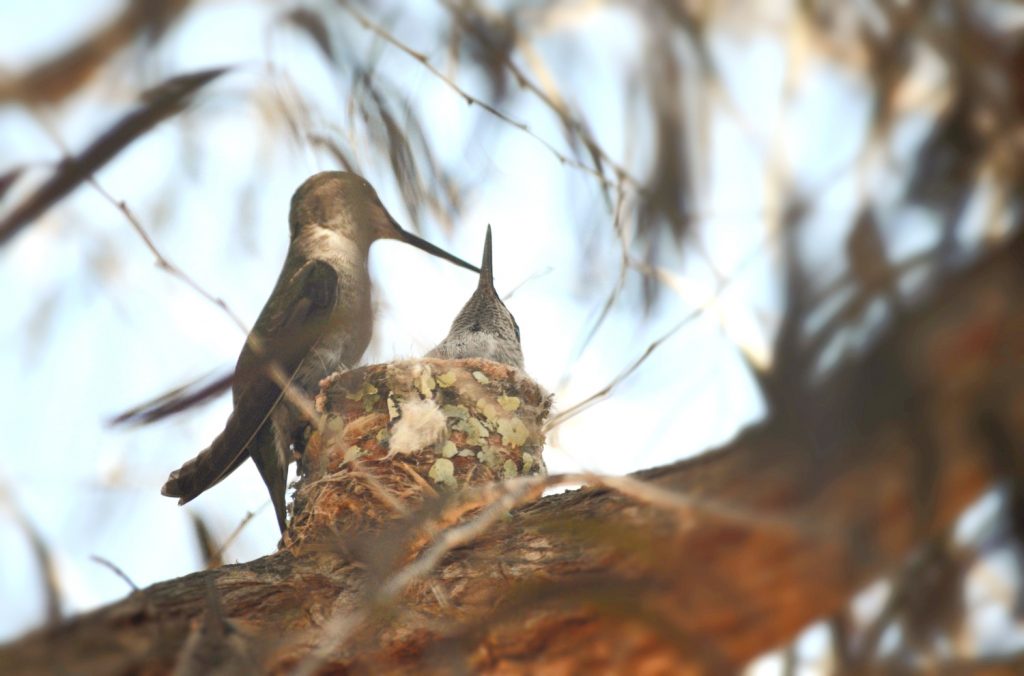
They’re guarding their territory
If you see a hummingbird flying back and forth, but there aren’t any food sources around, it could be guarding its territory.
Male hummingbirds are especially defensive of their territories and will chase other male hummingbirds away during mating season.
After mating, male hummingbirds leave nesting females alone while they incubate their eggs. Males do not bring females food, as many other birds do.
Even though males don’t care for nesting females the way sparrows and wrens might, they will go to great lengths to protect nesting females from other hummingbirds, flying back and forth to chase outsiders off.
You may also witness female hummingbirds flying back and forth as they feed and return to sit on their eggs, or as they gather food for their young.
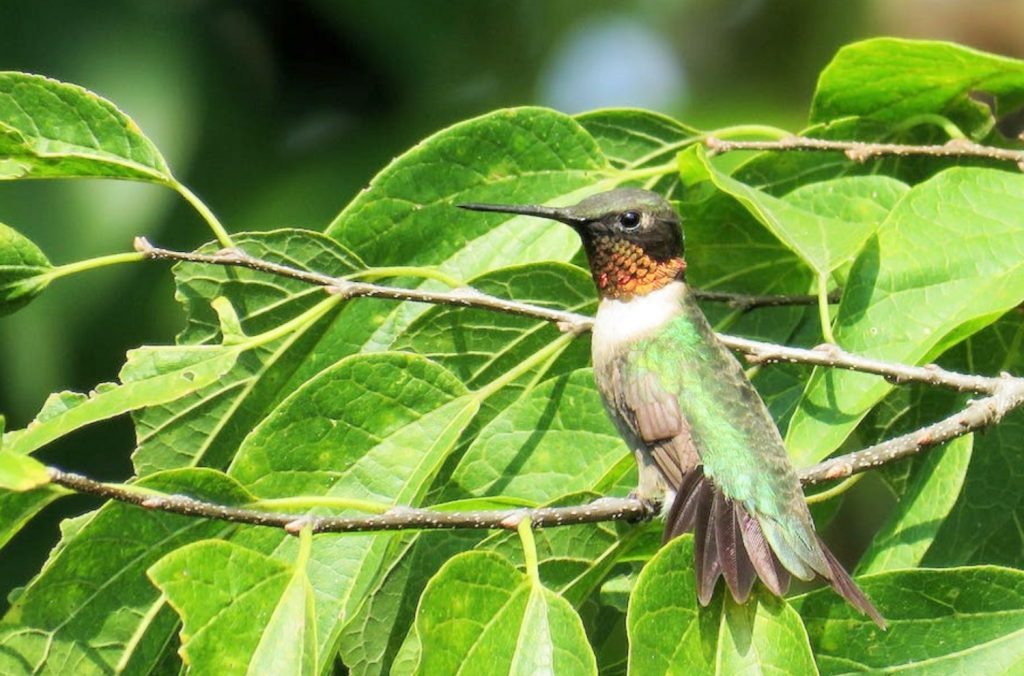
They’re protecting their food sources
There’s a good chance the answer to the question of why they’re flying around is pretty simple — they could be protecting their food sources.
Hummingbirds are pretty aggressive, in spite of their small size. Or maybe they’re aggressive because of their small size.
Hummingbirds have incredibly fast metabolisms. These birds can only go 3 to 5 hours without eating, and they must consume 1.5 to 3 times their body weight in insects and nectar per day to survive.
It’s no wonder hummingbirds are so protective of their food sources. To the hummingbirds in your backyard, your feeder means the difference between life and death.
Both male and female hummingbirds can be extremely aggressive towards each other, and can often be seen flying back and forth, chasing other hummingbirds away from a feeder that they’ve decided belongs to them.
Hummingbirds will also chase away wasps, bees, butterflies, and even larger birds, like orioles, if they try to visit their feeders.
That’s why providing your local hummingbirds with a variety of food sources is so important. It helps these birds conserve energy that they would otherwise be using to guard a single nectar source.
To help prevent infighting amongst your hummingbird flock, space your feeders at least 25 feet away, and plant a variety of hummingbird-friendly flowers, like lantana, sunflowers, lavender, and honeysuckle, to keep your little winged friends satisfied.
Fun Fact: The smallest hummingbird in the world is the bee hummingbird, and it measures just 2 ⅜ inches long from tail to beak. Females lay only two eggs at a time, each about the size of a coffee bean.
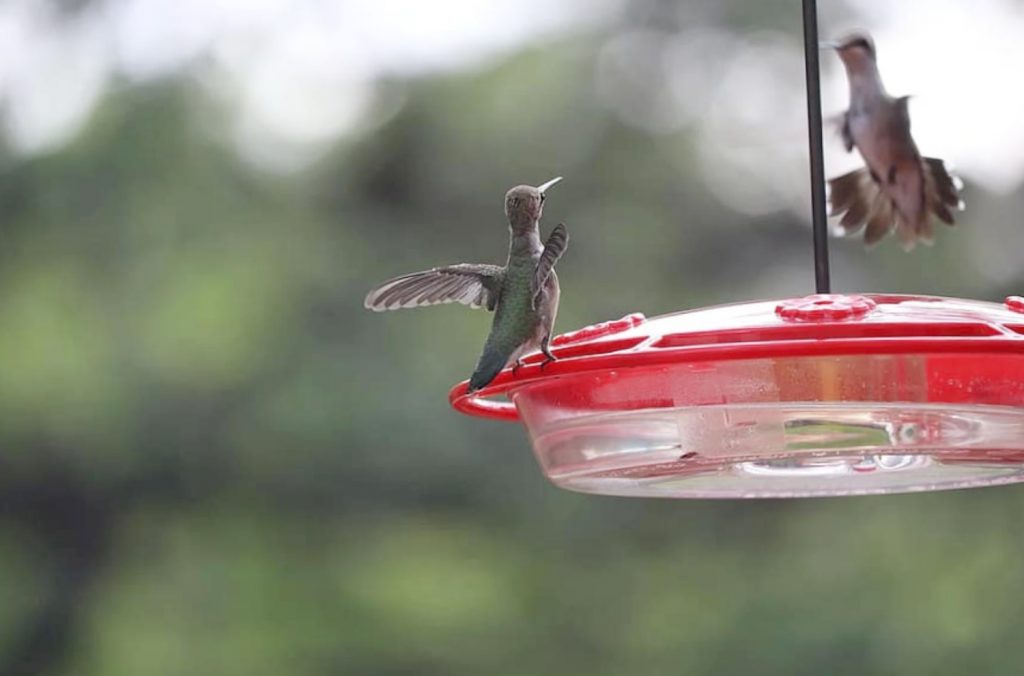
They’re foraging for food
You may notice hummingbirds darting hither and thither in search of food. Hummingbirds rely on sugar-rich nectars for quick energy, but they need plenty of protein to stay healthy, too.
Hummingbirds enjoy a variety of insects and will eat ants, mosquitoes, spiders, aphids, and flies. Hummingbirds also enjoy snacking on fruits, especially oranges and watermelons.
Try leaving a small dish of grape jelly out for your hummingbirds.
Hummingbirds love fruit jellies, just be sure to choose jellies that have been made with sugar, not artificial sweeteners, as these may upset the hummingbird’s delicate digestive system.
Leaving a variety of foods out for your hummingbirds, in addition to several nectar feeders, will make it easier for them to meet all of their nutritional needs.
It will also encourage them to spend more time in your backyard, where you can watch them up close and personal!
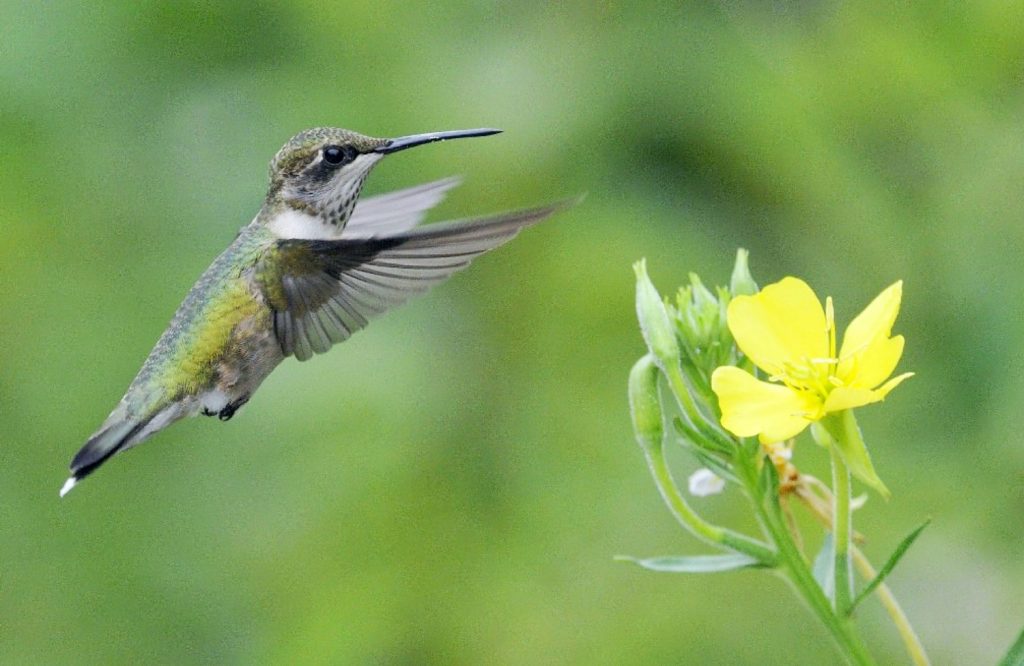
They’re searching for water
Hummingbirds drink a lot of nectar, and this helps keep them hydrated. But, like all other animals, hummingbirds like to have a reliable source of water nearby.
So, sometimes, the reason you see hummingbirds fly back and forth is because they’re in search of water.
Although the hustle and bustle created by other birds often deter hummingbirds, they will visit bird baths when other birds aren’t around.
Hummingbirds like to bathe in bird baths to give their feathers a good cleaning.
Hummingbirds are especially attracted to moving water, so add a solar-powered floating fountain to your bird bath to attract their attention.
They’re just practicing
Hummingbirds are skilled fliers, but all that swooping and diving takes practice.
Sometimes, hummingbirds fly back and forth simply because they’re trying to get better at it.
Young hummingbirds must practice their moves. Being an adept flier enables them to escape predators, outperform other hummingbirds, defend their mates and their territories, and fly long distances without tiring easily.
Hummingbirds spend much of their time flying, so they may fly back and forth simply to gain more experience. Plus, it’s probably fun. If we could fly that fast, we would probably fly back and forth, too!
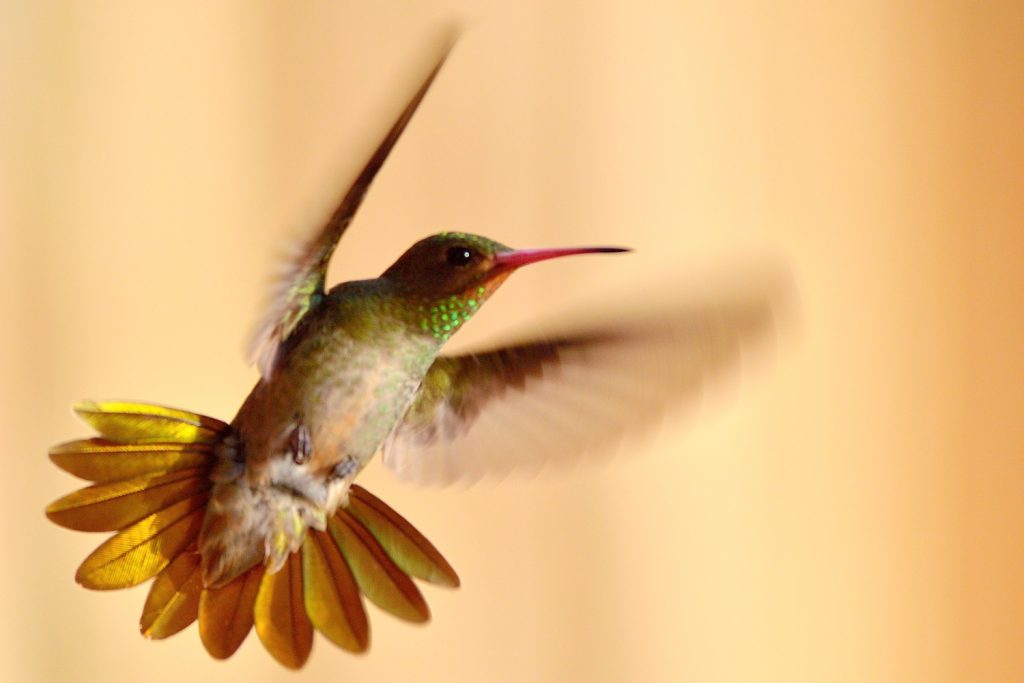
What can you do to support your backyard hummingbirds?
If you’re wondering, “Why do hummingbirds fly back and forth through my yard all day?” there are actually many different answers to this question.
But, on the plus side, at least you have lots of hummingbirds to enjoy!
Support your local hummingbirds by installing several feeders, filling them with homemade sugar water, and replacing the water regularly, to prevent the hummingbirds from getting sick.
Planting more native flowers and installing a bird bath or two will also encourage your backyard hummingbirds to take up residence, so you can witness their airborne antics from the comfort of your own porch.
If you see hummingbirds flying all over your yard, consider yourself lucky. Grab your binoculars and enjoy getting to enjoy these amazing creatures firsthand.
